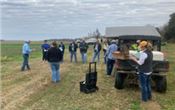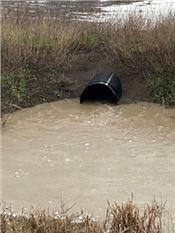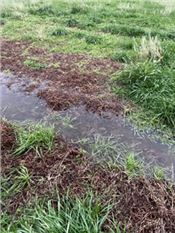Diversification In Crop Production Topic Of Winter Meeting
JOHNNY MORGAN
WEST MONROE, LOUISIANA
LSU AgCenter agents recently brought together row crop producers in the northeastern part of the state to look at ways to add variety to their farm operations.
For many years, AgCenter agents in the area along with crop specialists from across the state came together for what was known as the Annual Crop Forum.
Dennis Burns, AgCenter agent and research coordinator at the Northeast Research Station near St. Joseph, said this year they decided to restructure the forum into what is now known as the Northeast Louisiana Winter Crop Meeting.
“We separated the group into sections where some looked at peanuts, another looked at canola. And we had Dr. Mike Deliberto talk about the efficient use of grain bins in marketing,” he said.
In recent years, the area has seen increased interest in peanut production. And if the soil is suitable like a lot of it is in northeast Louisiana, it could be a profitable venture, Burns said.
“What we wanted to do is to show our producers that there are alternative crops and specialty crops that can be incorporated into their farm plan,” he said.
Bruce Garner, AgCenter agent in Morehouse Parish, said the northeast Louisiana Delta region is known for the traditional crops of cotton, corn, soybeans, rice and some sweet potatoes.
The attendees heard about the economics of growing peanuts, marketing strategies and production techniques, he said.
Peanuts are historically known as a staple crop in Georgia, but in recent years, Mississippi and Louisiana growers have started to get into the action.
Grain sorghum is another crop that once held a place in the Louisiana agricultural landscape. According to Garner, it for some reason lost popularity, but is now making a comeback.
AgCenter economists discussed sorghum growth and development, seeding rates and weed control, Burns said.
Other topics discussed included row spacing in corn and the benefits of 30-inch row spacing in soybeans, canola production practices, cover crops as a conservation practice and grain storage costs and marketing opportunities.
In addition to the Northeast Louisiana Winter Crop Meeting, agents in the region also put together a meeting to bring landlord landowners up to speed on the latest in farming practices.
Burns said some of the growers who are leasing the land that they farm have been running into issues with the landowners because of the condition of the land.
“The problem is the landowners are used to these clean, pristine rowed-up fields after the harvest,” Burns said. “Well, with no-till or minimum-till farming, it just won’t look pretty most of the time.”
He said the goal of that meeting was to let the landowners know that their fields may not look good, but leaving cover on the rows is doing good things for the soil.
“Some of the topics we covered at the landlord meeting included cover crop termination methods, cover crop seeding rates, treating a cover crop like a cash crop and crop rotation with cover crops and cash crops,” he said.
AgCenter Northeast Region Director Melissa Cater said there are some new varieties of canola being developed in Kansas, and some of those are being tried in northeast Louisiana.
“At the landowners meeting, we wanted to show them the advantages of using cover crops,” she said. “No-till or minimum-till farming is sometimes called ugly farming because the fields won’t be as clean and pristine.
Burns said they explained to the owners how certain cover crops help to build the nutrients in the soil. ∆
JOHNNY MORGAN: LSU AgCenter

James Hendrix, LSU AgCenter conservation agronomist, left, explains ways of treating a cover crop like a cash
crop during winter crop meetings in northeast Louisiana.
Photo by Dennis Burns/LSU AgCenter

Rainfall event runoff coming from a field of bare soil with no ground cover.

Same rainfall event runoff in a field with cover crops located close to the bare ground field.